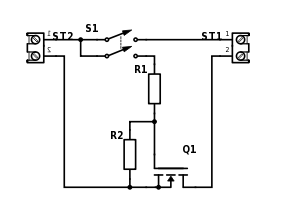Important: if you participate, make sure your setup is DC capable, don’t skip reading this chapter!
Electricity can always be dangerous, depending on the situation. A 1.5V battery can kill you if used improperly, it could start a fire. 230VAC can certainly kill you by electrocution, although it does not happen most of the times. It always gives you that nasty shock at least, that’s for sure! The point is that you always have to handle with care when you are playing with electronics.
We are building a Protected Extra Low Voltage power grid. In short this means: According to the Dutch NEN1010 norm we have to protect the grid from over-voltage conditions. The absolute maximum voltage here is 50VDC. We will make sure there is a redundant protection circuit at every node of the grid, shorting that node if it reaches 50V. Between 48V and 50V there is a protection that tries to dissipate the extra energy, so the shorting protection is not triggered that easy.
Switching up to 50VDC at a few Amps is not possible with most normal switches, even 230VAC switches are not suitable for that job. Use semiconductors, relay contacts in series, plugs, but don’t run currents of more than a few tens of milli-Amps through normal switches.
Relay contacts in series you said earlier, don’t you mean parallel? Nope! The air gaps when opening must be in series to extinguish the arc faster, this reduces wear on your contacts and doubles DC voltage breaking capacity of a single contact. If you put contacts in parallel you can not double the breaking capacity. Make sure the DC current rating is sufficient.

The schematic above will work from about 42V to 50V, but it’s not perfect. It just shows the basics of how to wire contacts in series.

The schematic above is a very basic way to use a switch and a MOSFET to disconnect DC. Make sure the maximum gate Voltage cannot be exceeded, choose the resistors properly! Don’t use resistors too big in value, this will turn the MOSFET off too slowly. If they are too small in value they might get too hot! For most MOSFETs on a 48V max. grid you can use 10k(R1) and 2.7k(R2). Power loss will be around 0.2W max with these values.
User-grid connection
You can connect a wire from a distribution cabinet to your tent, vehicle, project or village. Connect the wire for negative to a blue terminal block inside the cabinet. Connect the wire for positive to a circuit breaker. There are 4A and 16A breakers. Use thicker / shorter wire for lower losses. Please bring at least 25m of wire to the event. For a 4A connection, use 1.5mm2 to 6mm2 wire. For a 16A connection, 4mm2 to 16mm2 can be used. Using wire ferrules is recommended. If you are not certain how to connect your wire to the grid, we will help you.
